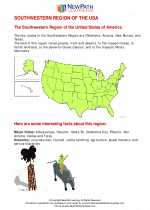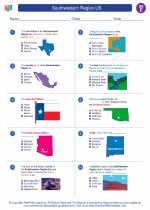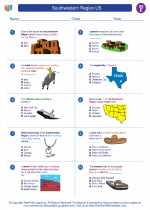Southwestern Region US
The Southwestern Region of the United States is a diverse and culturally rich area that encompasses the states of Arizona, New Mexico, Oklahoma, and Texas. This region is known for its unique blend of Native American, Hispanic, and cowboy cultures, as well as its stunning natural landscapes and rich history.Key Facts About the Southwestern Region
- States: Arizona, New Mexico, Oklahoma, Texas
- Major Cities: Phoenix, Tucson, Albuquerque, Oklahoma City, Dallas, Houston, San Antonio
- Landmarks and Natural Wonders: Grand Canyon, Carlsbad Caverns, Palo Duro Canyon, Big Bend National Park
- Cultural Influences: Native American, Hispanic, Cowboy
- Industries: Agriculture, Oil and Gas, Tourism, Technology
Study Guide Questions
- What are the states that make up the Southwestern Region of the United States?
- Which major cities are located in the Southwestern Region?
- What are some of the notable landmarks and natural wonders in the Southwestern Region?
- What are the main cultural influences in the Southwestern Region?
- What industries are important to the economy of the Southwestern Region?
◂Social Studies Worksheets and Study Guides Fifth Grade. Southwestern Region US
Study Guide Southwestern Region US
Southwestern Region US  Worksheet/Answer key
Worksheet/Answer key Southwestern Region US
Southwestern Region US  Worksheet/Answer key
Worksheet/Answer key Southwestern Region US
Southwestern Region US  Worksheet/Answer key
Worksheet/Answer key Southwestern Region US
Southwestern Region US 

 Worksheet/Answer key
Worksheet/Answer key
 Worksheet/Answer key
Worksheet/Answer key
 Worksheet/Answer key
Worksheet/Answer key

The resources above cover the following skills:
National Curriculum Standards for Social Studies (NCSS)
TIME, CONTINUITY, AND CHANGE
SOCIAL STUDIES PROGRAMS SHOULD INCLUDE EXPERIENCES THAT PROVIDE FOR THE STUDY OF THE PAST AND ITS LEGACY.
KNOWLEDGE - Learners will understand:
The origins and influences of social, cultural, political, and economic systems.
PEOPLE, PLACES, AND ENVIRONMENTS
SOCIAL STUDIES PROGRAMS SHOULD INCLUDE EXPERIENCES THAT PROVIDE FOR THE STUDY OF PEOPLE, PLACES, AND ENVIRONMENTS.
KNOWLEDGE - Learners will understand:
Concerts such as: location, region, place, and migration, as well as human and physical systems.
The concept of regions identifies links between people in different locations according to specific criteria (e.g., physical, economic, social, cultural, or religious).
Patterns of demographic and political change, and cultural diffusion in the past and present (e.g., changing national boundaries, migration, and settlement, and the diffusion of and changes in customs and ideas).
PROCESSES - Learners will be able to:
Ask and find answers to geographic questions related to regions, nations, and the world in the past and present.
National Center for History in Schools (NCHS)
United States History Content Standards
Era 1: Three Worlds Meet (Beginnings to 1620)
How early European exploration and colonization resulted in cultural and ecological interactions among previously unconnected peoples.
The student understands the Spanish and Portuguese conquest of the Americas.
World History Content Standards
Era 6: The Emergence of the First Global Age, 1450-1770
Economic, political, and cultural interrelations among peoples of Africa, Europe, and the Americas, 1500-1750.
The student understands how states and peoples of European descent became dominant in the Americas between the 16th and 18th centuries.
Major global trends from 1450-1770.
The student understands major global trends from 1450 to 1770.